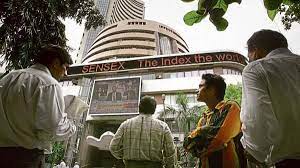http://sharetipsinfo.comJust get registered at Sharetipsinfo and earn positive returns

Indian benchmark indices ended on a flat note in the highly volatile session on September 27. After a positive start, the market remained in positive mode for most of the session. However, last-hour selling erased all the gains and the market ended with marginal losses.
At close, the Sensex was down 37.70 points or 0.07 percent at 57,107.52, and the Nifty was down 8.90 points or 0.05 percent at 17,007.40.
The Sensex and Nifty touched a high of 57,704.57 and 17,176.45, intraday, respectively.
Cipla, Tata Consumer Products, BPCL, Power Grid Corporation and Shree Cements were among the top gainers on the Nifty. Losers included Hero MotoCorp, Adani Ports, Titan Company, Tata Steel and Kotak Mahindra Bank.
Among sectors, Nifty auto, bank and metal indices shed 0.5 percent each, while buying was seen in pharma, FMCG and IT names.
--------------------------------------------------------------------------------------------
Topic :- Time:3.00 PM
Nifty spot if manages to hold above 16960 level on closing basis then expect some further upmove in coming sessions and if it closes below above mentioned level then some sluggish movement can be seen.
--------------------------------------------------------------------------------------------
Topic :- Time:2.30 PM
GOLD Trading View:
GOLD is trading at 49364.If it manages to trade and sustain above 49400 level then expect some quick upmove in it and if it breaks and trade below 49340 level then some decline can follow in it.
--------------------------------------------------------------------------------------------
Topic :- Time:1.45 PM
Just In:
Adani Group to invest $100 bn in a decade, focus on energy transition.
--------------------------------------------------------------------------------------------
Topic :- Time:1.15 PM
Just In:
Pharma firms may face legal action for unethical marketing practices.
--------------------------------------------------------------------------------------------
Topic :- Time:1.00 PM
Nifty is recovering from its lows. Nifty spot if manages to trade and sustain above 17100 level then expect some further upmove in the market and if it breaks and trade below 17060 level then some decline can follow in the Nifty.
--------------------------------------------------------------------------------------------
Topic :- Time:12.00 PM
Nifty spot is trading at 17046.If it manages to trade and sustain above 17060 level then expect some further upmove in the market and if it breaks and trade below 17020 level then some decline can follow in the Nifty.
--------------------------------------------------------------------------------------------
Topic :- Time:11.30 AM
News Wrap Up:
1. Sensex drops 150pts, Nifty50 below 17,000; Metal index down 2%
2. Robust demand for luxury products exposes widening inequality in India
3. Car makers on road to pre-Covid profit as festival season sales soar
4. Powering 5G services: Telcos may spend up to $2.5 billion on optical fibres
5. Metro Brands extends rally on strong outlook; zooms 69% in 2 months
6. SmallCap World Fund buys nearly 550k Mastek shares worth over Rs 96 cr
7. Aurobindo slips 6% in a week after arm receives EIR from USFDA
8. NBFCs recovery to be hit after RBI action against M&M Financial Services
--------------------------------------------------------------------------------------------
Topic :- Nifty Opening Note
Indian Stock Market Trading View For 27 Sept,2022:
Nifty to trade volatile and is likely to follow global cues. Bullions and USDINR to be monitored closely.
Nifty spot if manages to trade and sustain above 17060 level then expect some further upmove in the market and if it breaks and trade below 16960 level then some decline can follow in the market. Please note this is just opening view and should not be considered as the view for the whole day.
--------------------------------------------------------------------------------------------